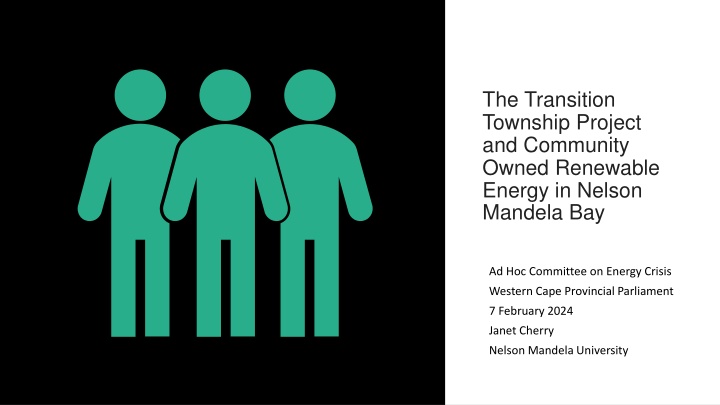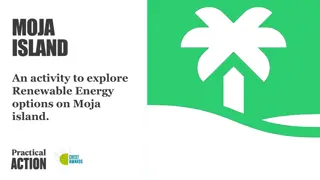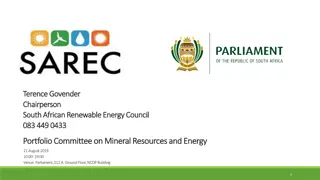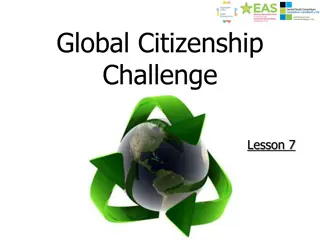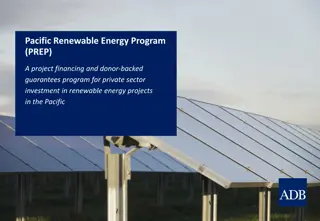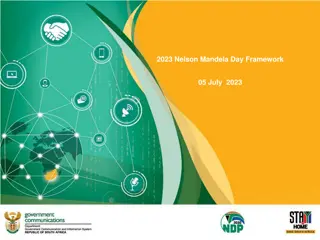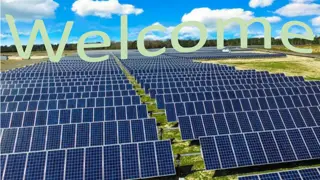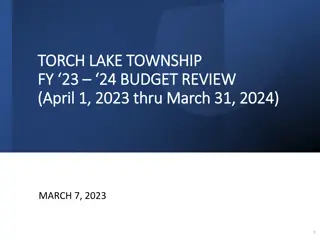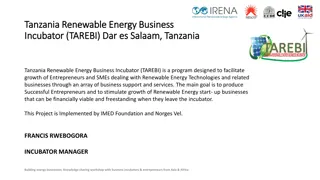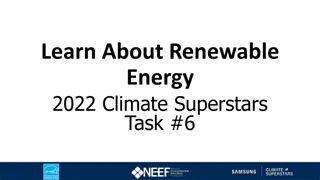The Transition Township Project and Community Owned Renewable Energy in Nelson Mandela Bay
The project focuses on community-owned renewable energy in Nelson Mandela Bay, aiming to empower townships like KwaZakhele for sustainable energy production and distribution. With a potential revenue of millions per annum, the initiative targets household installations and production networks to create a self-sufficient energy ecosystem. Through Gap Tap cooperatives and neighborhood production systems, the project envisions a thriving energy sector within the township, providing economic opportunities and energy independence.
Download Presentation

Please find below an Image/Link to download the presentation.
The content on the website is provided AS IS for your information and personal use only. It may not be sold, licensed, or shared on other websites without obtaining consent from the author.If you encounter any issues during the download, it is possible that the publisher has removed the file from their server.
You are allowed to download the files provided on this website for personal or commercial use, subject to the condition that they are used lawfully. All files are the property of their respective owners.
The content on the website is provided AS IS for your information and personal use only. It may not be sold, licensed, or shared on other websites without obtaining consent from the author.
E N D
Presentation Transcript
The Transition Township Project and Community Owned Renewable Energy in Nelson Mandela Bay Ad Hoc Committee on Energy Crisis Western Cape Provincial Parliament 7 February 2024 Janet Cherry Nelson Mandela University
Overview of KwaZakhele Approximately 25 000 households, population 120 000 Extensive commercial, industrial and public buildings, many of which are located along the main transport corridors running through the area. Highly skilled workforce (logistics, engineering, construction, manufacturing) but 50% unemployed Relatively high proportion of formal housing and service delivery
Enable township household owned production at scale to maximize surplus available for distribution Average household size Population Total investment required Potential revenue per annum Households Surplus per annum RSA 59,308,690 16,198,000 3.66 971,880,000,000 391,672,797,443 311,978,637,443 Eastern Cape 6,734,001 1,667,000 4.04 100,020,000,000 40,308,590,773 32,106,950,773 NMB 1,263,051 368,520 3.43 22,111,200,000 8,910,930,937 7,097,812,537 KwaZakhele 125,000 25,000 5.00 1,500,000,000 604,507,960 481,507,960 Ward 22 20,350 3,700 5.50 222,000,000 89,467,178 71,263,178 Saltuba Co-op 130 25 5.20 1,500,000 604,508 481,508 Ward 22 has potential to generate revenue of approximately R90 million, while KwaZakhele as a whole could generate over R600 million per annum
Emerging production networks of counter-power in NMB: Energy Production Retail, commerce and consumers? Suppliers Neighborhood Production systems Labour Household installation 4 kW Households City Energy Exchange kZk: 150 GWh NMB: 2.2 TWh Solar PV, Wind Turbines, Bio- digesters Local commerce and industry Township Mercantile Exchange CORE installation kZk 100 MW NMB: 1.5 GW City Commerce and Industry Sunshine, Wind, organic waste Value added services (e.g. repair and maintenance) Business services, Energy Management etc.
Finance model of Gap Tap Cooperatives for the whole of KwaZakhele Initial R1.5 million investment (R60 000 per household) generates approximately R600 000 per annum in revenue (R24 000 per household) for 25 years The model assumes that a portion of this amount (R125 000) will be used to cover the marginal cost to run and maintain the installation and that a substantial surplus (about R18 000) will be available for distribution to each participating household (after fixed costs e.g. loan repayments etc.). Average household income in the area is approximately R30 000 per annum so once a payback period is completed this has the potential to raise average household income by almost two thirds. Note: this additional income is received as a dividend based on household ownership of a share in the co-operative which owns (controls) the means of production NOT in wages for employment (although there will be some labour required for the supply, construction, operation and maintenance of the installation). In this context improved productivity using new technologies becomes desirable as it leads to an increase in the surplus available for distribution or re-investment
Emerging urban farming and production activities/potential Piggery Sustainable green production and research centre? Community vegetable garden Cattle Kraal Multiple Gap-Tap production nodes? Pond Six wetland conservation?
In theory household production could meet 83% of planned energy needs Current installed capacity (coal, nuclear, renewables etc.) is 52,104 MW Latest Integrated Resource Plan proposes installed capacity rising to 77,834 MW by 2030 (with most of the increase coming from renewable sources) If all 16 million households participate installed capacity would be 64,792 MW i.e. 124% of current installed capacity and 83% of planned capacity for 2030 Installed Rand value of production at current price capacity (MW) Production (kWh per annum) Households RSA 16,198,000 64,792 97,188,000,000 184,657,200,000 Eastern Cape 1,667000 6,668 10,002,000,000 19,003,800,000 NMB 368,520 1,474 2,211,120,000 4,201,128,000 KwaZakhele 25,000 100 150,000,000 285,000,000 Ward 22 3,700 15 22,200,000 42,180,000 Saltuba Co-op 25 0.1 150,000 285,000
JAP (Joint Action Projects and Participatory Design for Sustainable Development)
Current status, challenges and opportunities Changed energy environment: Just Energy Transition (JET P IP); changed regulatory framework at national level Water, food and energy challenges in NMBay . Presidential Climate Commission report on Models of Social Ownership of RE Urgency and opportunity: need to go to scale and implement SORE in municipalities Municipalities need regulatory framework and capacity Saltuba still unable to sell to grid - has a municipal account and has applied to sell electricity through a Wheeling Tariff. Support from NMBM economic devt (agriculture) fencing, water tanks, water and from Munelek for pilot. Training for Saltuba Coop members by Munelek Development of waste and energy app by Centre for Community Technologies
Is it scalable? Massive rollout of rooftop solar for the rich? Can working class townships benefit from RE? Can working class townships contribute to solving the energy crisis? Can municipal grids benefit from PV Solar in townships? Deregulation has meant massive expansion of rooftop solar but businesses and middle class going off grid Feed-in Tariffs are benefitting those with municipal accounts not using prepaid tokens
The future: A sustainable and just local economy for The future: A sustainable and just local economy for Nelson Mandela Bay Nelson Mandela Bay Democratic, participatory and inclusive leave nobody behind Decentralised solve problems where they occur , distribute ownership Mobilise available resources (finance, labour, technology, land, raw materials) Deploy the existing capability and infrastructure of the state and civil society (business, labour, community, non-profit, institutional etc.) Solve the problems we face (inequality, energy, food, water, waste etc.) Improve and build neighbourhoods fit for all residents to live in Repurpose existing and brownfield industrial plant, buildings and infrastructure to promote a circular economy which prioritises localised production
With thanks to: NIHSS (Catalytic project funding KDA) EnergyWorx (RE) Nelson Mandela University Trust, Ezethu Trust , Ikhala Trust, Urban Gardens (Saltuba food gardens) Wismar University, DAAD, STO and Bettina Benzoni-Ruffert Foundations(JAP) NRF (CORE and COCE app) Centre for Community Technology (waste app) CIPSET (cooperative support) NMBay (Munelek; Economic Devt, Tourism and Agriculture) Indalo World and PE College for design and Isuzu for materials NMU TT Team, KDA and Saltuba members
